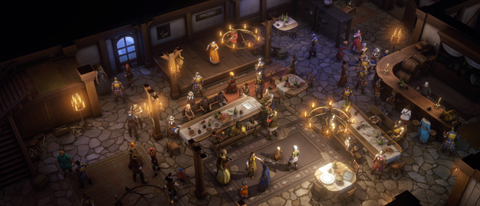Tom's Guide Verdict
Wrath of the Righteous is a beautiful love letter to tabletop RPGs that faithfully evokes the thrill of sitting down to play through an epic adventure.
Pros
- +
Great hybrid real-time/turn-based combat
- +
Gorgeous art design with charming, colorful landscapes
- +
Excellent adaptation of the Pathfinder tabletop RPG
- +
Effective tutorials
Cons
- -
Writing can be bland and dull
- -
Crusade army combat gets boring fast
Why you can trust Tom's Guide
Platforms: PC
Price: $50
Release Date: September 2, 2021
Genre: Isometric RPG
Pathfinder: Wrath of the Righteous is Owlcat Games’ newest isometric RPG, set in the universe of Paizo’s Pathfinder tabletop RPG. A follow-up to Owlcat’s first game, Pathfinder: Kingmaker, Wrath of the Righteous aims to deliver the experience of playing through an epic tabletop campaign without the hassle of having to get all your friends onboard and around a table (or a Zoom call) every week.
The game succeeds, for the most part, and that’s probably all you need to know if you’re already a Pathfinder fan. At its best, Wrath of the Righteous faithfully evokes the thrill of sitting down to play through a Pathfinder adventure, except the game does most of the work for you, and looks good doing it. At its worst, it frustrates you with dull writing, boring combat and buggy behavior.
The bugs will probably get squashed over time, given Owlcat’s track record of patching and updating Kingmaker, which is a significantly better game now than it was in 2018. But are the other weaknesses in Wrath of the Righteous enough to spoil the experience? I don’t think so, and hopefully this review will help you understand why.
Pathfinder: Wrath of the Righteous review: Gameplay
The team at Owlcat is upfront about taking inspiration from other isometric RPG series, from Baldur’s Gate to Pillars of Eternity. If you’re familiar with those games, you should feel right at home playing Wrath of the Righteous. The game gives you a bird's-eye view of a six-character party and challenges you to see them through the ups and downs of a good, old-fashioned crusade.
I do wish you could pull the view back a bit further, though. The 3D camera system in Wrath of the Righteous lets you spin your viewpoint around in a full circle, and you can zoom in or out a reasonable amount. But pulling out as far as possible still leaves the view feeling a bit more cramped than I’d like. I found myself constantly moving the camera around to scout the path ahead, less for potential threats than to simply see where to click next. I wanted a better sense of the world and my characters’ place in it.

Early on, you’ll spend the lion’s share of your time guiding the protagonist you’ve created (or picked from a list of pre-generated characters) through the streets of Kenabres, a fortified city at the edge of a big ol’ demon-infested region dubbed the Worldwound. You’ll meet a host of interesting characters and creatures adapted from the pages of Pathfinder’s Wrath of the Righteous tabletop adventure campaign, many of whom you’ll end up cutting down in either real-time or turn-based combat.
This is a significant change from Kingmaker, which had only real-time combat (with pausing), until a fan modded in a turn-based mode. The team at Owlcat reached out to the mod maker and referenced their work while designing Wrath of the Righteous. The result is that you can swap between real-time and turn-based combat pretty seamlessly while playing.

I love this feature, because it lets you tailor how much you want to be involved in combat. On Normal difficulty (which I played on for this review), you can pretty reliably sic your party on most enemies and watch the combat play out in real time, pausing occasionally to issue a specific order. But when you face off against challenging opponents, which demand careful resource management or complicated strategies, you can switch over to turn-based mode and micromanage your characters’ actions.
Obsidian offered a similar choice between real-time and turn-based combat in its 2018 isometric RPG Pillars of Eternity II: Deadfire. However, in that game, you had to choose when starting a new game, and couldn’t switch back and forth on the fly. Now that Wrath of the Righteous has shown me what it feels like to play a truly dynamic real-time/turn-based isometric RPG, I wish I never had to go back.
Pathfinder: Wrath of the Righteous review: Crusade management
Once you progress far enough, you’ll have the chance to leave Kenabres and start marching your merry band of crusaders on adventures around the surrounding territory. This takes the form of a colorful map laid out on a table, and covered with little figurines. It’s a clear love letter to an idealized tabletop gaming experience, and quite pretty to look at — which is nice, since you’ll spend at least a dozen hours over the course of a game staring at the map screen.
You'll spend much of that time managing the resources and troops of the Fifth Crusade, the in-game war effort against a demonic horde. Sometimes, that involves making dialogue choices and going on side quests. Most of the time, it means moving armies around the map and spending a separate set of Crusade-specific resources to hire troops or build structures in the areas you control. All this crusade management plays out on the same map that your adventuring party uses to move, and you can swap back and forth between the two modes at will.
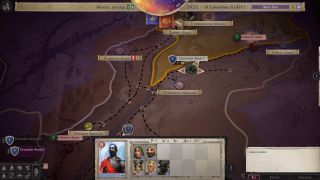
Building up your armies and winning battles are key to progressing the story. That can be frustrating if you don’t enjoy the army combat, which requires you and the enemy to take turns moving stacks of units around a grid-based battlefield. (Owlcat is upfront about this mode being an homage to the Heroes of Might & Magic series.)
Happily, if you don’t want to bother with the crusade management stuff, you can enable an auto mode, which will leave you free to focus on the adventuring part. This mode might be worth using, too, since I think you really need to get a kick out of the army combat to enjoy doing it for dozens and dozens of hours. Army battles can be long, dull, drawn-out affairs, too, though you have the option of auto-resolving them without having to play them out yourself.

I happen to love both isometric RPGs and Heroes of Might & Magic games, so the two layers of gameplay seem approachable and enjoyable to me. But if you haven’t played a game like this, you’ll likely face a steep learning curve in the early days of your crusade. This is especially frustrating, because a few bad losses can quickly leave you without enough resources to fight effectively.
Luckily, Wrath of the Righteous offers a pretty good set of in-game tutorials. It also offers plenty of difficulty levels and modifiers, which you can change on the fly, allowing you to dial down the challenge whenever it gets too frustrating.
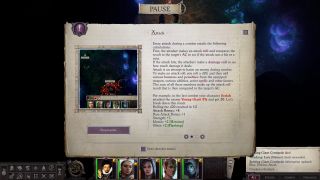
I encourage you to take advantage of this whenever you need to, because like the Pathfinder tabletop RPG, Wrath of the Righteous offers a nigh-overwhelming array of character races and classes to choose from. It’s very easy to put together a cool character idea on paper, only to discover that they get torn apart in particularly challenging fights. It's better to build a character who offers an intriguing perspective on the story of Wrath of the Righteous, than to build the optimal demon-killing machine — unless that’s the way you want to play the game.
Pathfinder: Wrath of the Righteous review: Story
Speaking of story and characters, Wrath of the Righteous has both in ample measure. I’m only midway through the second chapter of the game, despite putting in well over 30 hours. If the 120+ hours I put into Kingmaker is any indication, there are still hundreds of quests ahead of me.
So far the writing has been effective, but rarely surprising or compelling. Your protagonist meets a host of characters, many of whom first appeared in the published Pathfinder adventure path, and many of whom aren’t particularly interesting or memorable. The exceptions are the companions you can recruit to your party, who all seem to have complicated backgrounds, and side quests that you can explore or ignore as you see fit.
The companions all have their own unique perspectives on the narrative of Wrath of the Righteous, which uses the trappings of an honest-to-goodness crusade against demonkind to explore nuanced questions of good vs. evil, love vs. duty and law vs. chaos. Of course, as this is an isometric RPG, you will see your character quickly level up and gain a host of superhuman abilities, which you can use to answer most conundrums with a swift beating. In fact, that appears to be the only way the game lets you play a character with an evil alignment: by ruthlessly murdering anything that crosses your path.
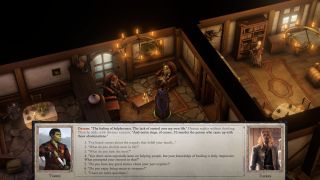
Throughout play you’ll encounter dialogue options with indicators like [Evil] or [Lawful], and if you choose them, the game will record that behavior. Many games offer similar systems, and few do enough to make playing an evil character seem worthwhile, or even believable. Wrath of the Righteous has a similar problem, as I’ve yet to see an [Evil] choice that was more complex than “kill this person right here, right now, for little to no reason."
In fact, the writing overall has been a bit more tedious and less enthralling than I’d like. There’s some good stuff in Wrath of the Righteous, especially when it comes to companion quests. A lot of the major plot beats will resound with anyone who has a soft spot for sword-and-sorcery romps. But more often than not, I find myself fast-forwarding through dialogue, skimming conversations for the most important bits and skipping past large swathes of text that make my eyes glaze over when they should be drawing me in. It’s good enough to get the job done, but when I think of how invested I was in similar games, such as Disco Elysium, Tyranny or Pillars of Eternity II: Deadfire, I can’t help but feel a bit put off by the sheer volume of bland text in Wrath of the Righteous.
Pathfinder: Wrath of the Righteous review: Visuals and sound
Like Kingmaker, Pathfinder: Wrath of the Righteous offers a mix of voiced and unvoiced dialogue, and so far, I’ve really enjoyed the performances. Most of the voiced dialogue sounds believable, and there are some genuinely funny lines that. It’s all supported by a solid soundtrack that punctuates the action without distracting from it.
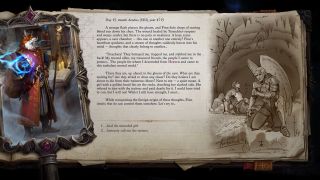
Many of the voiced characters also feature beautifully illustrated portraits, and much of the game features a similar level of detail. The character models are a bit more realistic than those in Kingmaker, yet still retain a cartoonish charm.
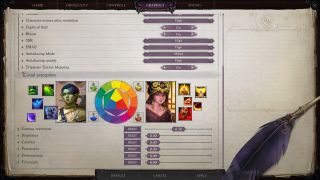
Weather and spell effects look striking, and the dynamic lighting helps the diorama-like environments feel like real places. The user interface is gorgeous, with lots of rich colors and design elements which evoke the feeling of sitting down around a table to plan an epic campaign.
Pathfinder: Wrath of the Righteous review: Verdict
If the thought of rolling up a character and sinking into an 80-hour fantasy RPG sounds like a good time, Pathfinder: Wrath of the Righteous might be just what you need.
This sophomore effort from Owlcat Games is a beautiful love letter to tabletop RPGs: one that evokes the same blend of curiosity and excitement I felt when I played my first game of D&D. But like a tabletop RPG campaign, Wrath of the Righteous can sometimes be tedious and dull, with writing that can feel a bit hollow and bland.
If you’re not excited by the prospect of a high-fantasy isometric RPG, you might get more enjoyment out of a game like Disco Elysium or Wasteland 3. But if you are in the mood for some old-fashioned demon-slaying action, Pathfinder: Wrath of the Righteous delivers it in spades, with more dragons and demon lords than you can shake a twenty-sided die at.

Alex Wawro is a lifelong tech and games enthusiast with more than a decade of experience covering both for outlets like Game Developer, Black Hat, and PC World magazine. A lifelong PC builder, he currently serves as a senior editor at Tom's Guide covering all things computing, from laptops and desktops to keyboards and mice.
